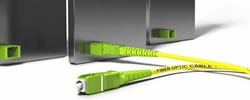What is broadband network noise and why is it difficult to find?
Setting up a broadband network for your business requires a lot of forethought and planning to ensure that it works optimally. There are several considerations that should be made when setting up your broadband network; failing to address these can lead to a whole host of issues that are likely to hamper your network performance and may also negatively impact your business operations and processes. Of the various issues that could affect a network, one of the most prevalent and challenging to manage is broadband network noise.

What Is Broadband Network Noise
In layman terms, broadband network noise refers to additional unwanted signals that impair or hinders the normal traffic of desired data signals within a broadband network. Network noise interferes with the information content being transmitted such that the recipient may receive only part of the information, or, in extreme cases, no information at all. Network noise is a major cause of impaired network performance; as such, it is important for it to be quickly recognized and resolved.
Causes of Broadband Network Noise
Broadband network noises are challenging to resolve because they have several varied causes which take a lot of time as well as effort to ascertain. The causes of network noise can be broadly categorized into external and internal causes. External causes are factors or circumstances outside the broadband network that can cause network noise. In contrast, internal causes of network noise are as a result of issues inherent within the broadband network.
1) External Causes
- Electromagnetic interference – Close proximity of the copper or fiber-optic wires of a broadband network to other electrical equipment such as power lines, generators, or motors can disrupt network signals.
- Radiofrequency interference – Unshielded copper wires can pick up radio waves and convert them into electrical signals, thereby generating noise within a broadband network.
- Cross talk – This is when other nearby cables or conductors trigger signals in wires within a broadband network.
- Environmental – Physical vibrations, as well as increased temperatures, can cause broadband network noise.
2) Internal Causes
- Improper grounding – If wires are not properly grounded, grounding loops can occur which generate additional unwanted signals within a network.
- Inadequate shielding – Network components that are not properly shielded have an increased propensity of picking up extra signals from external sources.
- Poor wiring techniques – Poor network wiring practices, such as using unshielded wiring, can result in additional electrical noise.
- Poor network design/layout – Faulty connections, loose network switches, or bad network circuitry can cause additional noise within a broadband network.
Effects Of Network Noise
Generally speaking, if network noise is not recognized and rectified in a timely manner, it can result in a degradation of overall network performance due to the following:
- Reduced data transfer rate – Signal interference as a result of network noise can reduce the speeds at which data is transmitted within the network.
- Signal attenuation – Network noise can weaken the strength of signals within a broadband network. The more the noise within a network, the greater the signals are attenuated.
- Loss of data packets – Network noise can cause data packets to be lost en route to its destination. When this occurs, some or all the information does not get transmitted to the recipient.
Management of Broadband Network Noise
The initial step in dealing with noise within a broadband network is to identify the cause. This is a time-intensive affair due to the number of factors that can cause network noise. The entire network should be thoroughly examined as well as tested in order to pinpoint the source of the unwanted noise. In addition, the external environment should be examined as well for potential triggers that can result in network noise.
At Promptlink, we know how detrimental noise can be to a broadband network and its impact on your business. For this reason, we have developed our proprietary Network NoiseHawk solution designed to localize the source of the network noise. Our patent-pending software solution, easily downloaded to a mobile device, collects data from multiple sources which it then uses to accurately pinpoint the source of the network noise. For more information about our NoiseHawk solution, contact us.
DOCSIS 4.0: Ushering in the Next Generation of Cable Internet
What is Wi-Fi 7? The New, Faster Standard
Trends in Set-Top Box Deployments
How Network NoiseHawkAI Is Changing Network Monitoring
Deciding if Automated Testing is Right for Your Application
Using AI Technology to Automate Pinpointing Upstream Noise
Pandemic-Related Component Shortages and the Impact Across the Broadband Industry
What is Wi-Fi 6 and Why is It Important?
What is CPE and Why Does It Matter?
Rural Broadband and FCC Expansion Explained
The Challenges of Monitoring Upstream Noise in a Remote PHY Environment
Why Promptlink Automated STB Solution is Right for You
What is broadband network noise and why is it difficult to find?
How Do You Measure Network Health and Performance









